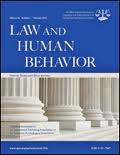 For juveniles, shame is positively related to psychopathic behaviors while guilt is negatively related to psychopathic characteristics. This is the bottom line of a recently published article in Law and Human Behavior. Below is a summary of the research and findings as well as a translation of this research into practice.
For juveniles, shame is positively related to psychopathic behaviors while guilt is negatively related to psychopathic characteristics. This is the bottom line of a recently published article in Law and Human Behavior. Below is a summary of the research and findings as well as a translation of this research into practice.
Featured Article | Law and Human Behavior | 2015, Vol. 39, No. 5, 451-462
Remorse, Psychopathology, and Psychopathy Among Adolescent Offenders
Author
Andrew Spice, Jodi L. Viljoen, Kevin S. Douglas, and Stephen D. Hart, Simon Fraser University
Abstract
Remorse has long been important to the juvenile justice system. However, the nature of this construct has not yet been clearly articulated, and little research has examined its relationships with other theoretically and forensically relevant variables. The present study was intended to address these issues by examining relationships among remorse, psychopathology, and psychopathy in a sample of adolescent offenders (N = 97) using the theoretically and empirically established framework of guilt and shame (Tangney & Dearing, 2002). Findings indicated that shame was positively related to behavioral features of psychopathy, whereas guilt was negatively related to psychopathic characteristics more broadly. In addition, shame was positively associated with numerous mental health problems whereas guilt was negatively associated with anger, depression, and anxiety. These results provide empirical support for theory that psychopathy is characterized by lack of remorse (e.g., Hare, 1991), and also underscore shame and guilt as potentially important treatment targets for adolescent offenders.
Keywords
remorse, psychopathy, adolescent offenders
Summary of the Research
“The construct of remorse has played a long-standing role in the juvenile justice system. Remorse is emphasized in Canadian and United States case law, legal scholarship and theory, and forensic psychological assessment instruments. Despite the apparent importance of this construct for justice-involved youth, however, little research has investigated its relationships with other theoretically related and forensically relevant constructs. The purpose of the present study was to examine the relationship of remorse with psychopathic characteristics and psychopathology among adolescent offenders.” (p. 391)
Remorse was conceptualized as guilt, shame, or a combination of both because an understanding of those concepts may provide a clearer picture of remorse, particularly in the context of psychopathy and psychopathology in juvenile offenders. These two constructs were tested with the Test of Self-Conscious Affect (TOSCA-A) and Offence-Related Shame and Guilt Scale (ORSGS). The TOSCA-A assesses guilt and shame through a series of 15 hypothetical scenarios that are unrelated to offending. The participant rates guilt and shame for each scenario on a 5-point Likert scale based on their own reactions to the scenarios. The ORSGS assesses guilt and shame based on previous criminal behavior. This tool uses 16 items on a 7-point Likert scale. The Massachusetts Youth Screening Instrument-2 (MAYSI-2) was used as a self-report tool to assess mental health for juveniles involved in the criminal justice system. The tool consists of 52 items with dichotomous answers of yes and no. The Psychopathic Checklist: Youth Version (PCL; YV) was used to assess psychopathic traits in juveniles. The tool consists of 20 items scored on a 3-point scale by a trained rater.
The main hypotheses of the study predicted a negative relationship between guilt and psychopathic traits and a positive relationship between shame and antisocial and behavioral aspects of psychopathy. Juveniles (n=97) were recruited from 11 probation offices in Canada. Data collection focused on structured interviews, self-report measures, and a review of probation files by trained research assistants.
“The present study was intended to investigate the relationship of guilt and shame with psychopathology and psychopathic characteristics among adolescent offenders. We strove to improve upon limitations of prior literature pertaining to remorse by addressing these questions using the theoretically and empirically established framework of guilt and shame. Our findings indicated that (a) shame was positively related to the behavioral features of psychopathy whereas guilt was negatively related to psychopathic characteristics more broadly, (b) shame was related to numerous mental health problems whereas guilt was negatively related to several of these problems, and (c) older youth evidenced lower levels of offense-related shame. Moreover, all associations held true after controlling for youths’ offense histories” (p. 457).
“With regard to mental health difficulties, present findings indicated that shame was positively associated with numerous forms of psychopathology, including depression, anxiety, suicide ideation, and somatic complaints. These results further underscore the harmful nature of shame, and suggest that its relationship with psychopathology as observed among noncriminal adults may generalize to an adolescent offender population. Given that the central features of shame are worthlessness, powerlessness, and a sense of a defective self, it is perhaps not surprising that this emotion is related to a range of pathological symptoms in youth just as it is in adults (p. 459).
“Guilt, on the other hand, was negatively related to anger, depression, and anxiety…Guilt is associated with acceptance of responsibility and constructive intentions, which are generally incompatible with the externalization of blame and destructive urges that can often accompany anger. Accordingly, our findings emphasize that guilt may be helpful in regulating anger among adolescent offenders” (p. 459).
Translating Research into Practice
“To our knowledge, this is the first study to empirically examined the long-held theoretical assertion that psychopathy is associated with a lack of guilt. In turn, these results provide empirical support for that aspect of psychopathy theory and also for the validity of the TOSCA-A and ORSGS. The consistency of our findings across both measures (i.e., general guilt vs. offense related guilt) is also in accordance with the notion that psychopathy involves general affective deficits across multiple domains.” (p. 458)
“Given high rates of mental disorder among adolescent offenders and present findings that shame is linked to numerous psychological symptoms, clinicians who assess and treat adolescent offenders may wish to place increased focus on shame. Assessment procedures, for instance, could include administration of the TOSCA-A and the ORSGS, which take relatively little time to administer and score. Using these measures rather than solely asking youths if they feel guilty or shameful may circumvent concerns that adolescents may falsely claim to experience these emotions to create a favorable impression for the evaluator” (p.459).
“In the case of intervention, shame-targeted protocols such as those included in dialectical behavior therapy (DBT) may be helpful. These procedures are effective in reducing shame among adult women with borderline personality disorder, and DBT as a complete treatment is effective for youth. Additional research is needed to determine whether such strategies are helpful for adolescent offenders” (p.460).
“Our findings also suggest that guilt, being negatively associated with psychopathology, may useful to encourage… A helpful alternative may be interventions that focus on building awareness and understanding of guilt, such as those in DBT. Such interventions may be especially relevant for youth high in psychopathic characteristics in light of present findings suggesting that these youth have consistent deficits in guilt across multiple domains” (p. 460).
Other Interesting Tidbits for Researchers and Clinicians
“The present findings did indicate that older youth were less likely to feel offense-related shame. Given that no mental health problems or psychopathic characteristics appeared to account for this association, it is possible that this finding represents adaptation to current circumstances (e.g., coping well with the emotional effects of an offense). Further research on age, shame, and resilience may clarify this possibility.” (p. 459)
Join the Discussion
As always, please join the discussion below if you have thoughts or comments to add!



















